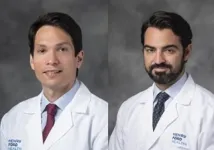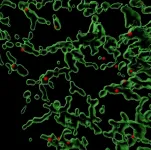Henry Ford Health cardiologists publish case series study on heart valve procedure
Procedure shows promise for treating severely calcified mitral valve stenosis.
2024-01-03
(Press-News.org) DETROIT (January 3, 2024) – Findings from a published case series research letter by the Henry Ford Health Structural Heart Disease team show that severe mitral stenosis, due to a build-up of calcium deposits in the mitral valve common in elderly patients, can be safely and successfully treated using Intravascular lithotripsy (IVL)-enabled percutaneous balloon mitral valvuloplasty. However, larger prospective studies in high-risk population are needed to confirm the findings.
These key takeaways from the research letter on IVL-facilitated valvuloplasty for severely calcified mitral valve stenosis are published in the Journal of the American College of Cardiology (JACC) Cardiovascular Interventions.
"We’ve developed a new strategy to treat our patients in the Detroit community and beyond," said corresponding author Pedro Engel Gonzalez, M.D., an interventional cardiologist and structural heart disease expert at Henry Ford Health. “We are looking forward to treating patients who have no other options for mitral stenosis diseased valves.”
IVL is a novel approach to lesion preparation of severely calcified plaques in coronary and peripheral vessels. Lithotripsy is delivered by vaporizing fluid to create an expanding bubble that generates sonic pressure waves that interact with arterial calcification.
In patients with severe mitral stenosis—which is the narrowing of the valve between the two left heart chambers that is a chronic degenerative process—who are not suitable for surgery or other transcatheter options, the IVL valvuloplasty is a possible option.
The Henry Ford team performed its first IVL-enabled mitral valvuloplasty back in 2019 and completed its first published case study. Now, the team has published its first case series report on the safety and efficacy of this procedure based on the 24 cases that have been performed so far.
The safety and efficacy results have Dr. Engel Gonzalez and the research team feeling very optimistic about the availability of this procedure to more patients going forward.
The research letter’s lead author, Gennaro Giustino, M.D., a Structural Heart Disease Fellow at Henry Ford Hospital, is also optimistic that these findings will lead to helping more people. “Patients with severely calcified mitral stenosis are often not candidates for conventional open-heart surgery,” said Dr. Giustino. “This minimally invasive technique pioneered at Henry Ford is a promising and safe treatment option for these patients to improve their cardiac symptoms and quality of life."
###
MEDIA CONTACT: mediarelations@hfhs.org.
END
ELSE PRESS RELEASES FROM THIS DATE:
2024-01-03
“[...] recent significant advances in understanding [...] CSC-Exos have revealed numerous potential applications for diagnosis and treatment.”
BUFFALO, NY- January 3, 2024 – A new editorial paper was published in Oncotarget's Volume 14 on December 20, 2023, entitled, “Therapeutically harnessing cancer stem cell-derived exosomes.”
In this editorial, researcher Yong Teng from Emory University discusses cancer stem cell-derived exosomes. Cancer stem cells (CSCs), a small population of cancer cells capable of self-renewal, are thought to serve ...
2024-01-03
Waltham — January 3, 2024 — Chronic pain affects approximately 60% of people living with traumatic brain injury (TBI), even up to 30 years after injury, according to new research published in The Journal of Head Trauma Rehabilitation (JHTR), the official journal of the Brain Injury Association of America. The journal is published in the Lippincott portfolio by Wolters Kluwer.
"This is the first study to examine the experience of chronic pain in a large TBI sample this far post-injury," explain Cynthia Harrison-Felix, PhD, FACRM, Co-Project Director of the TBI Model System ...
2024-01-03
A groundbreaking study published in the American Journal of Respiratory and Critical Care Medicine provides new insights into the treatment of obstructive sleep apnea (OSA) and its associated health impacts.
Researchers at the University of Missouri School of Medicine and the Marshall University Joan C. Edwards School of Medicine led by David Gozal, M.D., M.B.A., Ph.D. (Hon), vice president of health affairs at Marshall University and dean of the Joan C. Edwards School of Medicine, explored innovative therapeutic strategies that could greatly advance the understanding and management of OSA-related ...
2024-01-03
Seismic events that coincided with sudden drops in pressure within the Nord Stream 1 and 2 natural gas pipelines in September 2022 alerted the world to the rupture of pipelines in the western Baltic Sea. The suspected act of sabotage, which reportedly used explosive charges to rupture the pipelines, is still under investigation by multiple countries.
A new study published in The Seismic Record provides further evidence that the Nord Stream seismic signals came from a complex source. The signals lasted longer than would be expected from a single explosive source, the ...
2024-01-03
For children, the world is full of surprises. Adults, on the other hand, are much more difficult to surprise. And there are complex processes behind this apparently straightforward state of affairs. Researchers at the University of Basel have been using mice to decode how reactions to the unexpected develop in the growing brain.
Babies love playing peekaboo, continuing to react even on the tenth sudden appearance of their partner in the game. Recognizing the unexpected is an important cognitive ability. After all, new can also mean dangerous.
The exact way in which surprises are processed in the brain changes as we grow, however: unusual ...
2024-01-03
ANN ARBOR—Because same-sex sexual behavior does not result in offspring, evolutionary biologists have long wondered how the genes associated with this behavior have persisted in the human genome, and whether they will remain in the future.
A new University of Michigan-led study, scheduled for publication Jan. 3 in the journal Science Advances, suggests that part of the explanation—specifically for male bisexuals—has to do with risk-taking behavior.
The U-M researchers analyzed data from more than 450,000 participants of European ancestry in the United Kingdom's Biobank database of genetic and health information. Participants responded to a questionnaire ...
2024-01-03
Researchers have created a new brain imaging method that allows mild traumatic brain injuries (mTBIs) to be diagnosed, even when existing imaging techniques like magnetic resonance imaging (MRI) don’t show any structural abnormalities. The technique involves loading gadolinium, a standard MRI contrast agent, into hydrogel-based micropatches that are attached to immune cells called macrophages. mTBIs cause inflammation in the brain, which produces signals that attract macrophages to migrate there. Coupling the gadolinium contrast agent to these cells enables MRI to reveal ...
2024-01-03
Weill Cornell Medicine researchers received a $2.4 million grant from the U.S. Department of Defense Breast Cancer Research Program to validate a new blood test for the early detection of breast cancer.
Researchers are evaluating Syantra DX Breast Cancer (Syantra Inc.), an experimental diagnostic test that detects specific biomarkers in blood associated with breast cancer. The test uses an artificial intelligence algorithm to determine whether a patient is positive for cancer as soon as detectable by mammogram or possibly earlier, and before symptoms arise.
“This new liquid biopsy, ...
2024-01-03
Scientists have created a new treatment for traumatic brain injury (TBI) that shrank brain lesions by 56% and significantly reduced local inflammation levels in pigs. The new approach leverages macrophages, a type of white blood cell that can dial inflammation up or down in the body in response to infection and injury. The team created disc-shaped microparticles called “backpacks” containing anti-inflammatory molecules, then attached them directly to the macrophages. These molecules kept the cells in an anti-inflammatory state ...
2024-01-03
MADISON – Like mail carriers who manage to deliver their parcels through snow, rain, heat and gloom, a critical group of mammalian proteins helps cells function properly even under less-than-ideal conditions.
Using state-of-the-art cell imaging and genome editing technology, University of Wisconsin–Madison scientists have begun to unravel how this collection of proteins performs its essential service. The discovery could eventually help researchers better understand and develop new treatments for diseases like cancer, diabetes and those that cause immune dysfunction.
Led by Anjon Audhya, a professor in the Department of Biomolecular Chemistry, the research team sought ...
LAST 30 PRESS RELEASES:
[Press-News.org] Henry Ford Health cardiologists publish case series study on heart valve procedure
Procedure shows promise for treating severely calcified mitral valve stenosis.




